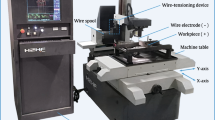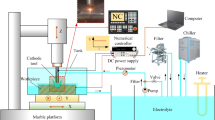Abstract
An ITO layer is produced using semiconductor techniques, although the defect rate during production is easily seen. Current work presents a new modus of electrochemical machining using a ‘design recycle’ system offering faster performance in removing the color filter surface’s ITO layer. Higher electrical current is not required when an effective feeding electrode is used to reduce the response area. Through establishing an ultra-precise recycling process to remove the thin film microstructure, this helps the semiconductor optoelectronic industry to reduce both production costs and pollution. The design features of the removal processes for a thin film and the tool design of plate-form electrode are of major interest. In the current experiment, the author utilizes a 5th Generation TFT-LCD. The design of tool electrodes is used with continuous and pulsed direct current in the electrochemical machining experiment. High rotational speed of the tool electrodes and high flow velocity of the electrolyte elevates the discharge mobility and improves the removal effect. Pulsed direct current can improve the effect of dregs discharge and is advantageous to associate with the fast feed rate of the workpiece. A color filter with a fast feed rate is combined with enough electric power to provide highly effective removal. A smaller end radius and a thin plate-form positive-electrode provide a larger discharge space and better removal effect. A precision recycling process is presented using an effective plate-form positive-electrode in electrochemical machining. It only needs a short period of time to remove the ITO layer easily and cleanly.











Similar content being viewed by others
References
Shima T, Itakura T, Minamizaki, H, Maruyama T (1997) Proc Int ISSCC’, Kawasaki, Japan 97:192
Avenel E, Barlet C (2000) J Econ Manage Strategy 9(3):211
Takabatake M, Ohwada J, Ono YA, Ono K, Mimura A, Konishi, N (1991) IEEE Trans Electron Devices 38(6):1303
Guh HS (2004) MNew Wun Ching Developmental Publishing Co., Ltd., Taiwan
Biai I, Quinteda M, Mendes, L et al (1999) Int’l J Thin Solid Films 337:171
Kim H-C, Kwon B-H, Choi M-R (2001) IEEE Trans Electron 47
Daeil K, Steven K (2002) Int’l J Surf Coat Technol 154:204
Lee P, Chen H (2005) IEEE Conference Proceeding 1:780
Wilson J (1971) Wile-Interscience. New York, NY, 79
Phillips RE (1996) Carbide Tool J 18(6):12
Mileham AR, Harrey SJ, Stout KJ (1986) The Characterization of Electrochemically Machined Surfaces, Wear 109:207
McGeough JA (1974) Principles of electrochemical machining. Chapman & Hall, London
Bannard J (1977) J Appl Electrochem 7:267
Datta M, Landolt D (1983) J Appl Electrochem 13:795
Shen WM (1995) M.Sc. Thesis, National Yunlin Institute of Techndogy, Taiwan
Mansour SS (1980) I A S; Sedahmed, G H Surface Technol 10(5):357
Datta M, Landolt D (1981) Elector Acta 26(7):899
Rajurkar KR (1995) Annals of the CIRP 44:177
Cagnon L, Kirchner V, Kock M, Schuster R, Ertl G, Gmelin WT, Kuck, H (2003) Z Phys Chem 217:299
Jain VK, Yogindra, PG, Murugan S (1987) Int J Mach Tools Manufact 27(1):1135
Hocheng H, Pa PS (2002) 120:6
Hocheng H, Pa PS (2003) J Mater Process Technol 142(1):203
Hocheng H, Pa PS (2004) 20(4):312
Pa PS (2006) Mater Sci Forum 5:32–533:965
Kim BH, Ryu SH, Choi, SH, Chu CN (2005) J Micromechanics and Microengineering 15:124
Acknowledgement
The current study is supported by BEN TEN THE CO., The current study is supported by National Science Council, contract 95-2622-E-152-001-CC3 and 95-2622-E-152-001-CC3.
Author information
Authors and Affiliations
Corresponding author
Rights and permissions
About this article
Cite this article
Pa, P.S. Precision removal of ITO layer using plate-form tool design. J Solid State Electrochem 12, 1445–1451 (2008). https://doi.org/10.1007/s10008-007-0492-0
Received:
Revised:
Accepted:
Published:
Issue Date:
DOI: https://doi.org/10.1007/s10008-007-0492-0




